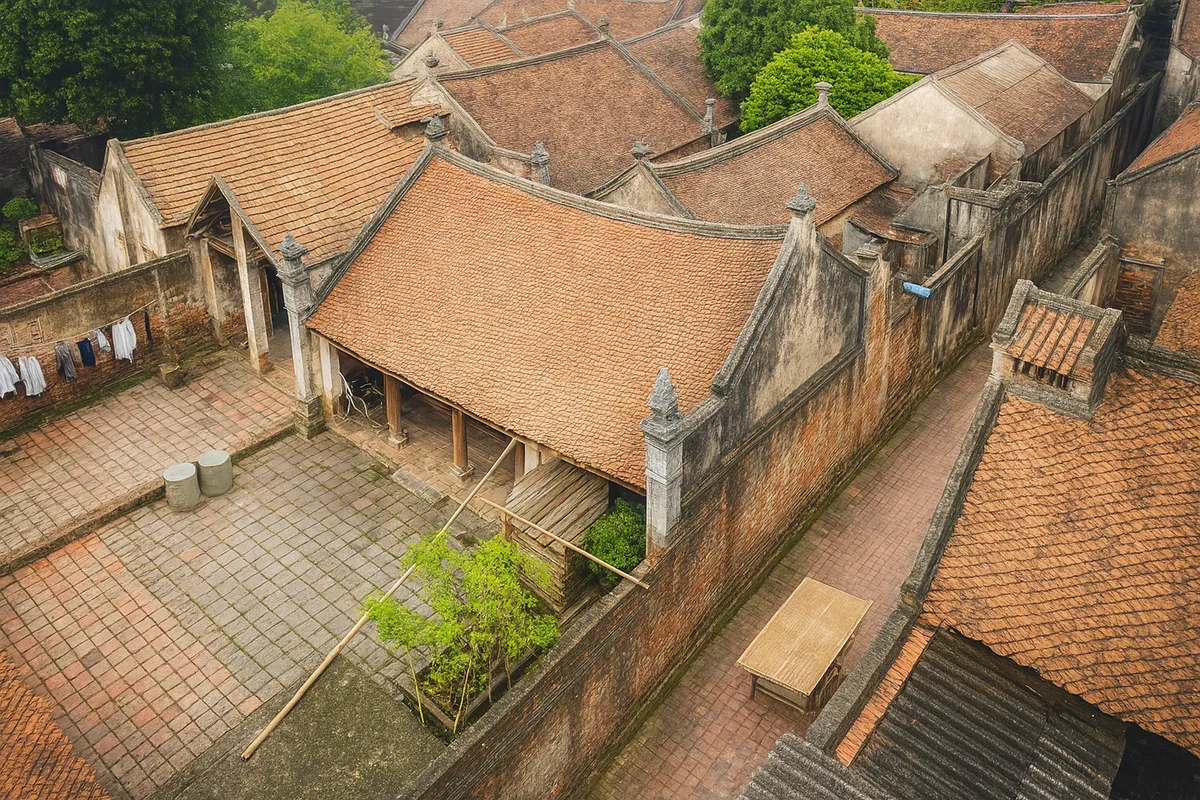Thi Pho Ancient Village and the Gentle Echoes of Time
- Saturday, Jul 05, 2025, 19:20 (GMT+7)
Thi Pho Ancient Village and the Gentle Echoes of Time
Thi Pho Ancient Village rests quietly along the coast of Quang Ngai, like an untold story tucked between rolling hills and the murmuring sea. This place does not just appear on a map. It unfolds like a living painting, where time lingers and every element breathes the presence of the past. From the very first moment, the name Thi Pho Ancient Village ceases to be just a location and becomes an atmosphere, where the whisper of ocean breeze and the scent of burning wood blend into a soft rhythm of living history.
There are no grand gates or flashy signposts. The path to Thi Pho is a narrow earthen trail shaded by old bamboo and dotted with purple sim flowers blooming between the green hush. The only music here is the rustle of palm leaves and the steady murmur of distant waves. A gentle call pulling the traveler into a space where time is measured not in minutes but in the depth of one’s breath.
Among this serene scenery, ancient stone wells emerge like echoes of a forgotten time. Crafted from perfectly stacked granite without cement or binding, they have endured centuries with nothing but human ingenuity and the patience of stone. The water within reflects not just the sky but centuries of history. Of the Sa Huynh people who once lived here, of Cham dynasties who prayed by stone bridges, and of Vietnamese ancestors who turned this coastal land into a vibrant village. Few places in Vietnam carry such rich cultural sediment. Sa Huynh, Champa and Dai Viet layered together in one space. With every step, one can feel history underfoot, not displayed in glass boxes but humming softly beneath the grass and stone.
Thi Pho does not shout for attention. It carries beauty in its silence. Thatched houses tucked under coconut palms, stone fences neatly assembled by weather-worn hands, pathways etched into the earth through generations of footsteps. These roads, uneven with moss and memory, are where elders take slow morning strolls and children chase sunlight in laughter. It is a place where even the air seems to carry a story, thick with sea salt and the warmth of familiarity.
Legends here linger like the mist at dawn. Locals tell of vast grasslands that once fed horses of imperial guards, giving rise to the village’s name Thi Pho. A soft name, rooted in survival and duty, whispered through the ages. And in this village, ancient Cham structures still stand. Old stone irrigation systems, inscribed relics and remnants of forgotten shrines shine faintly in the afternoon light, as if history has not yet let go.
Few know that Thi Pho holds the highest number of ancient wells in the region, with over eleven of them scattered quietly across the village. Each one carries its own name and story. The central well once hosted village rituals, another is said to reveal ancestral spirits under moonlight. These are not just wells. They are lifelines. Guardians of memory. Witnesses to unspoken generations. No one dares alter them. They are sacred not by decree but by collective reverence.
By midmorning, the sea begins its song. Not a roar, but a soft rhythmic chant brushing against the rocky shore. Here, ancient sedimentary cliffs sculpted by wind and wave resemble sleeping dragons and stone ships. Locals call them story rocks because they change shape over the years, as if the sea itself carves its feelings into them.
Young travelers are drawn to the seaside cliffs at sunset, where the sky turns molten gold and the horizon catches fire. In those moments, words often fall silent. There is nothing left but the breath of wind, the lull of waves and the gentle realization that sometimes peace is not found in noise but in the quiet spaces between memories.
Tourism here follows no packaged routes. Instead, every experience is an honest exchange with the villagers. Guests stay in humble homes, rise with the roosters, cook local meals, pound rice, gather seaweed, mend nets. When rain falls, the entire village stills under its steady rhythm. When night comes, stories are shared around wood fires. Of war and survival, of dreams once cast out to sea, and of stones believed to hold the voice of time.
When asked about the best season to visit, villagers simply say come when your heart seeks peace. Yet the months between March and August are particularly gentle, with calm seas, clear skies and dawns wrapped in fine mist. The journey from Quang Ngai takes about two hours along a scenic route of rice fields and coastal hills. The final stretch narrows into a sandy road where even strangers receive nods of familiarity.
The food here is as sincere as the people. A small rice cake made of cassava, a bowl of seaweed soup simmered at sunrise, a crisp banh xeo wrapped in banana leaves served with wild herbs. Each dish speaks in whispers, telling tales of soil and tide.
Today, Thi Pho stands as one of the country’s exemplary community-based tourism models. Operated by local cooperatives, it is not a site of flashy development but a quiet guardian of identity. From reviving traditional festivals to preserving age-old crafts, everything is driven by authenticity and care. Even the fences, stone upon stone, stand resilient through storms. Built without mortar, yet held together by legacy and respect.
One curious fact not widely known is that these dry stone walls, assembled entirely by hand, have withstood centuries of typhoons without ever crumbling. They are not just barriers. They are chronicles etched in rock, holding stories that cannot be written, only lived.
Thi Pho does not promise modern comfort. What it offers instead is space. Space to slow down. To feel the sun, the rain, the weight of silence. It is a place where one can lie back on a cliff, close their eyes and listen. Not just to the sea but to something older and deeper.
Many who leave Thi Pho linger just a moment longer before stepping away. Not because of any grand farewell, but because something soft has settled in their chest. A feeling, like a fallen leaf drifting in a still well. Quiet, light and enduring. Something that hums long after the journey ends.
Thi Pho is not simply a destination. It is a return. To origin, to heritage, to the most beautiful forms of simplicity. One visit is enough to understand that beauty does not always shout. Sometimes, it simply waits.

 CHECKIN.VN
CHECKIN.VN








Share on